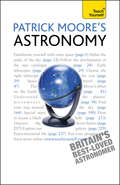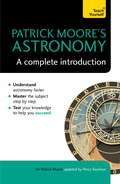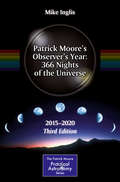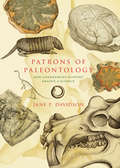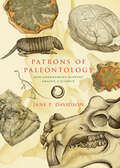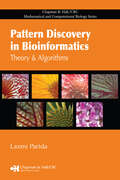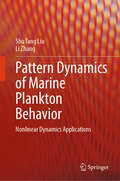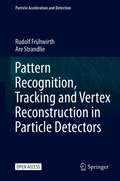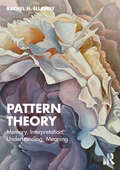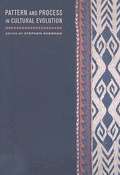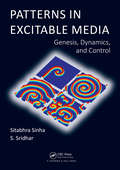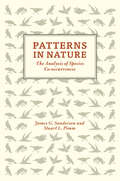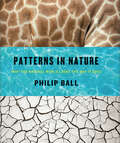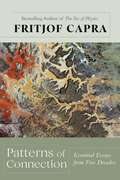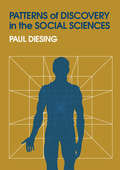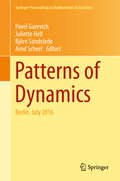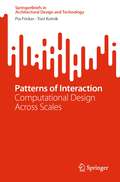- Table View
- List View
Patrick Moore's Astronomy: Teach Yourself
by Patrick MoorePatrick Moore's Astronomy will ensure you recognize what you are seeing in the night sky. You will investigate the sun, moon, planets comets and stars and learn how to observe them. This comprehensive guide, complete with star charts, will map out the skies and allow you to impress your friends with your knowledge of the sky at night.NOT GOT MUCH TIME?One, five and ten-minute introductions to key principles to get you started.AUTHOR INSIGHTSLots of instant help with common problems and quick tips for success, based on the author's many years of experience.TEST YOURSELFTests in the book and online to keep track of your progress.EXTEND YOUR KNOWLEDGEExtra online articles at www.teachyourself.com to give you a richer understanding of astronomy.FIVE THINGS TO REMEMBERQuick refreshers to help you remember the key facts.TRY THISInnovative exercises illustrate what you've learnt and how to use it.
Patrick Moore's Astronomy: Teach Yourself
by Patrick Moore Percy SeymourAstronomy: A Complete Introduction will ensure you recognize what you are seeing in the night sky. You will investigate the sun, moon, planets comets and stars and learn how to observe them. This comprehensive guide, complete with star charts, will map out the skies and allow you to impress your friends with your knowledge of the sky at night. Astronomy: A Complete Introduction includes: Chapter 1: Introducing Astronomy Chapter 2: The spinning sky Chapter 3: Sky-watchers Chapter 4: The astronomer's telescope Chapter 5: Into space Chapter 6: The Sun Chapter 7: The Moon Chapter 8: The Sun's family Chapter 9: The inner planets Chapter 10: The outer planets Chapter 11: Minor members of the Solar System Chapter 12: The stars Chapter 13: Pattern of stars Chapter 14: Double and variable stars Chapter 15: The life and times of a star Chapter 16: The Star-clusters and nebulae Chapter 17: The depths of the universe Chapter 18: Into the future - life beyond the Earth
Patrick Moore's Observer's Year: 366 Nights of the Universe
by Mike InglisObservers no longer need to wonder what they will turn their attention to each night of the year with this updated text of a beloved favorite from Sir Partick Moore. His night-by-night account of the stars is the best possible guide an observer could ask for, and now includes the latest data for the years 2015-2020, preserving and extending Sir Patrick Moore's legacy. This new edition of his classic text makes it easy to see why Sir Patrick Moore was such a helpful guide to generations of budding astronomers, professional and amateur alike. For every night of the year Patrick gives the reader details of interesting objects that can be seen from Earth. It is a book for people with a wide interest in practical astronomy, those who may not have specialized in a specific area of astronomy and wish to expand their knowledge in all areas. Moore updated his book in a second edition in 2005, giving astronomical events through 2010, but a more current version has been desperately lacking. This third edition includes Sir Patrick's original text but revises its time-sensitive material and adds all of the points of interest that change from year to year, such as eclipses, occultations, planetary positions, and so on. Sir Patrick Moore left behind an enormous legacy, including the world's longest-running television series with the same original presenter, the BBC's The Sky at Night, and more than 70 written works. His influence on the world of amateur astronomy was phenomen al, and his knowledge and passion led many to take up observing as a life-long hobby. This book, "The Observer's Year, 366 Nights of the Universe" was, he said, one of his personal favorites. It now features a tribute to Patrick Moore's legacy as well as including what has changed in astronomy since the previous edition ten years ago.
Patrones Crecientes (Growing Patterns): Los números de Fibonacci en la naturaleza
by Sarah C. CampbellAn ALSC Notable Children's BookA wondrous introduction to one of the most beautiful connections between mathematics and the natural world—the Fibonacci sequence—through a series of stunning nature photographs.Discover the biggest mathematical mystery in nature—Fibonacci numbers! Named after a famous mathematician, the number pattern is simple and starts with: 1, 1, 2, 3, 5, 8, 13. Each number in the sequence comes from adding the two numbers before it. What's the mystery? The pattern crops up in the most unexpected places. You'll find it in the disk of a sunflower, the skin of a pineapple, and the spiral of a nautilus shell. This book brings math to life, celebrates science, and inspires kids to see nature through new eyes.
Patrons of Paleontology: How Government Support Shaped a Science
by Jane P. DavidsonIn the 19th and early 20th centuries, North American and European governments generously funded the discoveries of such famous paleontologists and geologists as Henry de la Beche, William Buckland, Richard Owen, Thomas Hawkins, Edward Drinker Cope, O. C. Marsh, and Charles W. Gilmore. In Patrons of Paleontology, Jane Davidson explores the motivation behind this rush to fund exploration, arguing that eagerness to discover strategic resources like coal deposits was further fueled by patrons who had a genuine passion for paleontology and the fascinating creatures that were being unearthed. These early decades of government support shaped the way the discipline grew, creating practices and enabling discoveries that continue to affect paleontology today.
Patrons of Paleontology: How Government Support Shaped a Science (Life of the Past)
by Jane P. DavidsonA history of North American and European governments supporting paleontology in the nineteenth and twentieth centuries, and the motivation behind it.In the nineteenth and early twentieth centuries, North American and European governments generously funded the discoveries of such famous paleontologists and geologists as Henry de la Beche, William Buckland, Richard Owen, Thomas Hawkins, Edward Drinker Cope, O. C. Marsh, and Charles W. Gilmore. In Patrons of Paleontology, Jane Davidson explores the motivation behind this rush to fund exploration, arguing that eagerness to discover strategic resources like coal deposits was further fueled by patrons who had a genuine passion for paleontology and the fascinating creatures that were being unearthed. These early decades of government support shaped the way the discipline grew, creating practices and enabling discoveries that continue to affect paleontology today.“This slim book, graced with beautiful facsimile reproductions of gorgeous paleontological folio art, is a treasure trove of vertebrate paleontological history, sacred and arcane.” —The Quarterly Review of Biology“Patrons of Paleontology is a good introduction to the ambitious individuals and institutions that pursued their own, national, and institutional interests over centuries in a variety of contexts.” —Journal of American History“Who pays for palaeontological research and why? Patrons of Paleontology will be a useful reference guide for anyone interested in the early history of the subject and some of the social and historical context in which it occurred.” —Paul Barrett, Priscum, The Newsletter of the Palentological Society
Pattern Discovery in Bioinformatics: Theory & Algorithms
by Laxmi ParidaThe computational methods of bioinformatics are being used more and more to process the large volume of current biological data. Promoting an understanding of the underlying biology that produces this data, Pattern Discovery in Bioinformatics: Theory and Algorithms provides the tools to study regularities in biological data.Taking a systema
Pattern Dynamics of Marine Plankton Behavior: Nonlinear Dynamics Applications
by Li Zhang Shu Tang LiuTo ultimately address this serious issue, this book begins with the nonlinear dynamic characteristics of marine plankton, focusing on the dynamic behavior of both two-dimensional and spatiotemporal patterns. As a critical foundation of marine ecosystems, the frequent outbreaks of marine phytoplankton and the toxicity of planktonic animals pose significant threats to marine ecological security and human health. One of the primary reasons we currently struggle to effectively manage the safety issues surrounding marine plankton is the extremely complex nature of their growth environment, which exhibits intricate dynamic and nonlinear characteristics. By constructing reaction-diffusion models and fractional diffusion systems of the planktonic ecosystem, the book characterizes the various factors in different environments and studies the nonlinear behavior of marine organisms. Employing linear stability theory, multi-scale analysis, comparison principle, analytical techniques, and the construction of Lyapunov functions, the book delves into the following topic: the stability of the plankton ecosystem, Hopf bifurcation, Turing bifurcation and other local bifurcations, spatial self-organization behavior of marine plankton, the formation of spatiotemporal patterns, and the persistence and extinction properties and characteristics. Marine ecology and the marine environment are currently hot research topics internationally, with the behavior of marine organisms being a core area of this research. The goal of exploring these issues is to scientifically understand the features of marine organisms, control their behavior, manage ocean pollution effectively, contribute to human development, and support social advancement. Additionally, the authors aime to make academic contributions and provide guidance to graduate students and researchers dedicated to this field.
Pattern Formation and Dynamics in Nonequilibrium Systems
by Michael Cross Henry GreensideMany exciting frontiers of science and engineering require understanding the spatiotemporal properties of sustained nonequilibrium systems such as fluids, plasmas, reacting and diffusing chemicals, crystals solidifying from a melt, heart muscle, and networks of excitable neurons in brains. This introductory textbook for graduate students in biology, chemistry, engineering, mathematics, and physics provides a systematic account of the basic science common to these diverse areas. This book provides a careful pedagogical motivation of key concepts, discusses why diverse nonequilibrium systems often show similar patterns and dynamics, and gives a balanced discussion of the role of experiments, simulation, and analytics. It contains numerous worked examples and over 150 exercises. This book will also interest scientists who want to learn about the experiments, simulations, and theory that explain how complex patterns form in sustained nonequilibrium systems.
Pattern Formation in Morphogenesis
by Vincenzo Capasso Annick Harel-Bellan Misha Gromov Linda Louise Pritchard Nadya MorozovaPattern Formation in Morphogenesis is a rich source of interesting and challenging mathematical problems. The volume aims at showing how a combination of new discoveries in developmental biology and associated modelling and computational techniques has stimulated or may stimulate relevant advances in the field. Finally it aims at facilitating the process of unfolding a mutual recognition between Biologists and Mathematicians of their complementary skills, to the point where the resulting synergy generates new and novel discoveries. It offers an interdisciplinary interaction space between biologists from embryology, genetics and molecular biology who present their own work in the perspective of the advancement of their specific fields, and mathematicians who propose solutions based on the knowledge grasped from biologists.
Pattern Recognition and Classification
by Geoff DoughertyThe use of pattern recognition and classification is fundamental to many of the automated electronic systems in use today. However, despite the existence of a number of notable books in the field, the subject remains very challenging, especially for the beginner. Pattern Recognition and Classification presents a comprehensive introduction to the core concepts involved in automated pattern recognition. It is designed to be accessible to newcomers from varied backgrounds, but it will also be useful to researchers and professionals in image and signal processing and analysis, and in computer vision. Fundamental concepts of supervised and unsupervised classification are presented in an informal, rather than axiomatic, treatment so that the reader can quickly acquire the necessary background for applying the concepts to real problems. More advanced topics, such as semi-supervised classification, combining clustering algorithms and relevance feedback are addressed in the later chapters. This book is suitable for undergraduates and graduates studying pattern recognition and machine learning.
Pattern Recognition, Tracking and Vertex Reconstruction in Particle Detectors (Particle Acceleration and Detection)
by Rudolf Frühwirth Are StrandlieThis open access book is a comprehensive review of the methods and algorithms that are used in the reconstruction of events recorded by past, running and planned experiments at particle accelerators such as the LHC, SuperKEKB and FAIR. The main topics are pattern recognition for track and vertex finding, solving the equations of motion by analytical or numerical methods, treatment of material effects such as multiple Coulomb scattering and energy loss, and the estimation of track and vertex parameters by statistical algorithms. The material covers both established methods and recent developments in these fields and illustrates them by outlining exemplary solutions developed by selected experiments. The clear presentation enables readers to easily implement the material in a high-level programming language. It also highlights software solutions that are in the public domain whenever possible. It is a valuable resource for PhD students and researchers working on online or offline reconstruction for their experiments.
Pattern Theory: Memory, Interpretation, Understanding, Meaning
by Rachel H. EllawayPattern Theory is a groundbreaking exploration of the concept of pattern across a range of disciplines, including science, neuroscience, psychology, and social sciences.This book examines the meaning and implications of pattern, presenting a comprehensive body of theory that unifies concepts of form, order, and regularity and connects them to memory and perception. By challenging existing orthodoxies and linking evidence from brain and mind function, it outlines a robust theoretical framework around pattern searching and matching, pattern activation, and the continuity of pattern nexuses. This in-depth study of pattern theory and pattern thinking delves into the cognitive basis of patterns, their impact on reasoning and learning, and the social and collaborative nature of pattern recognition, expression, and representation. It also addresses philosophical issues and implications surrounding shared pattern thinking and introduces a broad conceptual basis for "pattern inquiry", providing a range of questions and methodologies for applying pattern theory. The book culminates in a manifesto for pattern theory and its application in pattern inquiry, offering 50 key principles that can be applied across various settings. Researchers, scholars, and practitioners are encouraged to explore and critique this unified theory as a lens for examining social and cognitive phenomena.Ideal for academics and professionals seeking to challenge their understanding of the connections between mind and society, as well as for those looking to deepen their understanding of pattern as a cognitive phenomenon, as a theoretical lens, and as a meta-methodology for inquiry, this text provides a substantive foundation for ongoing development and application of pattern science across multiple fields.
Pattern and Process in Cultural Evolution
by Stephen ShennanThis volume offers an integrative approach to the application of evolutionary theory in studies of cultural transmission and social evolution and reveals the enormous range of ways in which Darwinian ideas can lead to productive empirical research, the touchstone of any worthwhile theoretical perspective. While many recent works on cultural evolution adopt a specific theoretical framework, such as dual inheritance theory or human behavioral ecology,Pattern and Process in Cultural Evolution emphasizes empirical analysis and includes authors who employ a range of backgrounds and methods to address aspects of culture from an evolutionary perspective. Editor Stephen Shennan has assembled archaeologists, evolutionary theorists, and ethnographers, whose essays cover a broad range of time periods, localities, cultural groups, and artifacts.
Patterns Identification and Data Mining in Weather and Climate (Springer Atmospheric Sciences)
by Abdelwaheb HannachiAdvances in computer power and observing systems has led to the generation and accumulation of large scale weather & climate data begging for exploration and analysis. Pattern Identification and Data Mining in Weather and Climate presents, from different perspectives, most available, novel and conventional, approaches used to analyze multivariate time series in climate science to identify patterns of variability, teleconnections, and reduce dimensionality. The book discusses different methods to identify patterns of spatiotemporal fields. The book also presents machine learning with a particular focus on the main methods used in climate science. Applications to atmospheric and oceanographic data are also presented and discussed in most chapters. To help guide students and beginners in the field of weather & climate data analysis, basic Matlab skeleton codes are given is some chapters, complemented with a list of software links toward the end of the text. A number of technical appendices are also provided, making the text particularly suitable for didactic purposes.The topic of EOFs and associated pattern identification in space-time data sets has gone through an extraordinary fast development, both in terms of new insights and the breadth of applications. We welcome this text by Abdel Hannachi who not only has a deep insight in the field but has himself made several contributions to new developments in the last 15 years. - Huug van den Dool, Climate Prediction Center, NCEP, College Park, MD, U.S.A.Now that weather and climate science is producing ever larger and richer data sets, the topic of pattern extraction and interpretation has become an essential part. This book provides an up to date overview of the latest techniques and developments in this area. - Maarten Ambaum, Department of Meteorology, University of Reading, U.K.This nicely and expertly written book covers a lot of ground, ranging from classical linear pattern identification techniques to more modern machine learning, illustrated with examples from weather & climate science. It will be very valuable both as a tutorial for graduate and postgraduate students and as a reference text for researchers and practitioners in the field. - Frank Kwasniok, College of Engineering, University of Exeter, U.K.
Patterns in Excitable Media: Genesis, Dynamics, and Control
by S. Sridhar Sitabhra SinhaExcitable media comprise a class of models for a wide range of physical, chemical, and biological systems that exhibit spontaneous formation of spatial patterns. Patterns in Excitable Media: Genesis, Dynamics, and Control covers recent developments in the interdisciplinary field of dynamics and control of patterns in nonlinear biological systems described by excitable media models. Using examples of many real-life systems, it explores the impact of pattern dynamics on the structural and functional heterogeneities in the system. The book also discusses low-amplitude control schemes for eliminating patterns from an excitable medium, such as life-threatening cardiac arrhythmia. Codes for numerical simulation are provided in the appendix.
Patterns in Nature: The Analysis of Species Co-Occurrences
by James G. Sanderson Stuart L. PimmWhat species occur where, and why, and why some places harbor more species than others are basic questions for ecologists. Some species simply live in different places: fish live underwater; birds do not. Adaptations follow: most fish have gills; birds have lungs. But as Patterns in Nature reveals, not all patterns are so trivial. Travel from island to island and the species change. Travel along any gradient--up a mountain, from forest into desert, from low tide to high tide on a shoreline --and again the species change, sometimes abruptly. What explains the patterns of these distributions? Some patterns might be as random as a coin toss. But as with a coin toss, can ecologists differentiate associations caused by a multiplicity of complex, idiosyncratic factors from those structured by some unidentified but simple mechanisms? Can simple mechanisms that structure communities be inferred from observations of which species associations naturally occur? For decades, community ecologists have debated about whether the patterns are random or show the geographically pervasive effect of competition between species. Bringing this vigorous debate up to date, this book undertakes the identification and interpretation of nature's large-scale patterns of species co-occurrence to offer insight into how nature truly works. Patterns in Nature explains the computing and conceptual advances that allow us to explore these issues. It forces us to reexamine assumptions about species distribution patterns and will be of vital importance to ecologists and conservationists alike.
Patterns in Nature: The Analysis of Species Co-occurrences
by James G. Sanderson Stuart L. PimmWhat species occur where, and why, and why some places harbor more species than others are basic questions for ecologists. Some species simply live in different places: fish live underwater; birds do not. Adaptations follow: most fish have gills; birds have lungs. But as Patterns in Nature reveals, not all patterns are so trivial. Travel from island to island and the species change. Travel along any gradient—up a mountain, from forest into desert, from low tide to high tide on a shoreline —and again the species change, sometimes abruptly. What explains the patterns of these distributions? Some patterns might be as random as a coin toss. But as with a coin toss, can ecologists differentiate associations caused by a multiplicity of complex, idiosyncratic factors from those structured by some unidentified but simple mechanisms? Can simple mechanisms that structure communities be inferred from observations of which species associations naturally occur? For decades, community ecologists have debated about whether the patterns are random or show the geographically pervasive effect of competition between species. Bringing this vigorous debate up to date, this book undertakes the identification and interpretation of nature’s large-scale patterns of species co-occurrence to offer insight into how nature truly works.Patterns in Nature explains the computing and conceptual advances that allow us to explore these issues. It forces us to reexamine assumptions about species distribution patterns and will be of vital importance to ecologists and conservationists alike.
Patterns in Nature: Why the Natural World Looks the Way It Does
by Philip BallThe acclaimed science writer &“curates a visually striking, riotously colorful photographic display…of physical patterns in the natural world&” (Publishers Weekly, starred review). Though at first glance the natural world may appear overwhelming in its diversity and complexity, there are regularities running through it, from the hexagons of a honeycomb to the spirals of a seashell and the branching veins of a leaf. Revealing the order at the foundation of the seemingly chaotic natural world, Patterns in Nature explores not only the math and science but also the beauty and artistry behind nature&’s awe-inspiring designs. Unlike the patterns we create, natural patterns are formed spontaneously from the forces that act in the physical world. Very often the same types of pattern and form—such as spirals, stripes, branches, and fractals—recur in places that seem to have nothing in common, as when the markings of a zebra mimic the ripples in windblown sand. But many of these patterns can be described using the same mathematical and physical principles, giving a surprising unity to the kaleidoscope of the natural world. Richly illustrated with 250 color photographs and anchored by accessible and insightful chapters by esteemed science writer Philip Ball, Patterns in Nature reveals the organization at work in vast and ancient forests, powerful rivers, massing clouds, and coastlines carved out by the sea. By exploring similarities such as the branches of a tree and those of a river network, this spectacular visual tour conveys the wonder, beauty, and richness of natural pattern formation.
Patterns of Connection: Essential Essays from Five Decades
by Fritjof CapraWinner of the Silver Medal for Environment/Ecology in the 2022 Independent Publisher (IPPY) Book AwardsFritjof Capra, scientist, educator, activist, and accomplished author, presents the evolution of his thought over five decades in Patterns of Connection. First introduced in the late 1950s to the work of Werner Heisenberg, a founder of quantum mechanics, Capra quickly intuited the connections between the discoveries of quantum physics and the traditions of Eastern philosophy—resulting in his first book, the bestselling The Tao of Physics. This synthesis, representative of the change from the mechanistic worldview of Descartes and Newton to a systemic, ecological one, went on to inform Capra&’s thinking about the life sciences, ecology, and environmental policy. His observations of sustainable communities in nature inspired his work on systems theory—the complex web of interrelated processes that organize everything from biological systems to social, cultural, and political systems.Today Fritjof Capra remains a major figure at the crossroads of physics, spirituality, environmentalism, and systems theory. Organized thematically and chronologically, the essays in Patterns of Connection document the revolutionary and far-reaching intellectual journey of one of the major public thinkers of the last half-century.
Patterns of Discovery in the Social Sciences
by Paul DiesingSocial scientists are often vexed because their work does not satisfy the criteria of "scientific" methodology developed by philosophers of science and logicians who use the natural sciences as their model. In this study, Paul Diesing defines science not by reference to these arbitrary norms delineated by those outside the field but in terms of norms implicit in what social scientists actually do in their everyday work.
Patterns of Dynamics: Berlin, July 2016 (Springer Proceedings in Mathematics & Statistics #205)
by Pavel Gurevich Juliette Hell Björn Sandstede Arnd ScheelTheoretical advances in dynamical-systems theory and their applications to pattern-forming processes in the sciences and engineering are discussed in this volume that resulted from the conference Patterns in Dynamics held in honor of Bernold Fiedler, in Berlin, July 25-29, 2016.The contributions build and develop mathematical techniques, and use mathematical approaches for prediction and control of complex systems. The underlying mathematical theories help extract structures from experimental observations and, conversely, shed light on the formation, dynamics, and control of spatio-temporal patterns in applications. Theoretical areas covered include geometric analysis, spatial dynamics, spectral theory, traveling-wave theory, and topological data analysis; also discussed are their applications to chemotaxis, self-organization at interfaces, neuroscience, and transport processes.
Patterns of Earth and Sky: Analyzing Stars on Ancient Artifacts, Investigation Notebook
by The Lawrence Hall of ScienceNIMAC-sourced textbook
Patterns of Interaction: Computational Design Across Scales (SpringerBriefs in Architectural Design and Technology)
by Pia Fricker Toni KotnikThis book is a reflection on contemporary computational design thinking at the intersection of architecture, urban design, and landscape architecture, in a time marked by complex challenges like climate change, urbanization and population growth. Based on a critical rethinking of the notion of ground and the relation between the manmade and the natural environment, an understanding of architecture as regenerative practice is proposed. It aims at a built environment as landscape, at an architecture of prosthetic nature. The design approach is illustrated by a number of design experiments conducted within a studio setting and complemented by a series of conversations with leading experts on sustainable design and landscape architecture.
